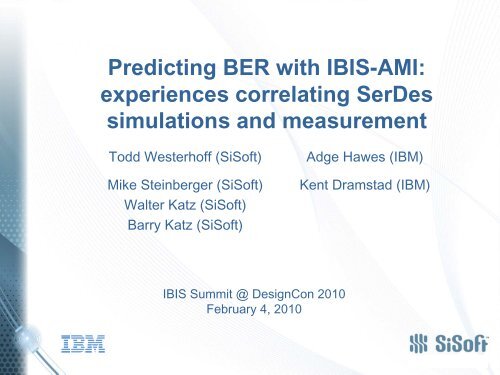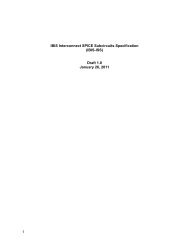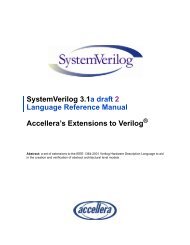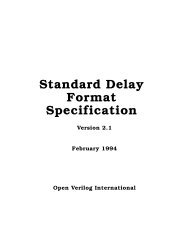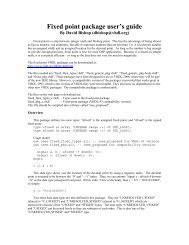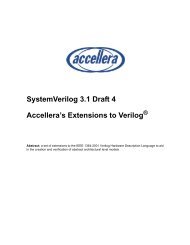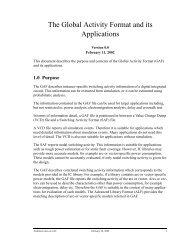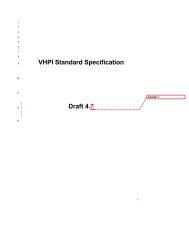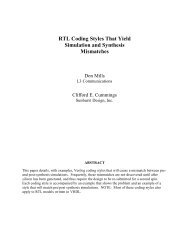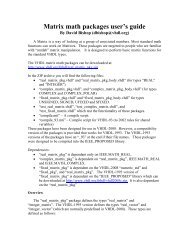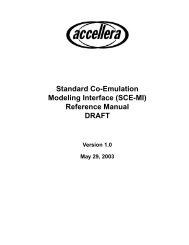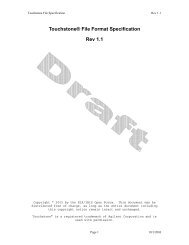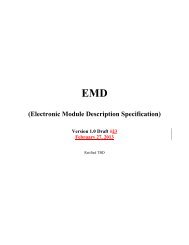Predicting BER with IBIS-AMI - VHDL International
Predicting BER with IBIS-AMI - VHDL International
Predicting BER with IBIS-AMI - VHDL International
You also want an ePaper? Increase the reach of your titles
YUMPU automatically turns print PDFs into web optimized ePapers that Google loves.
<strong>Predicting</strong> <strong>BER</strong> <strong>with</strong> <strong>IBIS</strong>-<strong>AMI</strong>:<br />
experiences correlating SerDes<br />
simulations and measurement<br />
Todd Westerhoff (SiSoft)<br />
Mike Steinberger (SiSoft)<br />
Walter Katz (SiSoft)<br />
Barry Katz (SiSoft)<br />
<strong>IBIS</strong> Summit @ DesignCon 2010<br />
February 4, 2010<br />
Adge Hawes (IBM)<br />
Kent Dramstad (IBM)
Agenda<br />
• <strong>IBIS</strong>-<strong>AMI</strong> Overview<br />
• IBM’s <strong>IBIS</strong>-<strong>AMI</strong> Models<br />
• Correlation Methodology<br />
• Correlation Results w/o Jitter/Noise<br />
• Jitter / Noise Modeling & Extrapolation<br />
• <strong>IBIS</strong>-<strong>AMI</strong> Performance<br />
<strong>Predicting</strong> <strong>BER</strong> <strong>with</strong> <strong>IBIS</strong>-<strong>AMI</strong> – DesignCon 2010 – February 4, 2010 – 2<br />
© 2010, IBM, SiSoft. All Rights Reserved
The SerDes Simulation Problem<br />
� Model SerDes EQ & CDR<br />
� Simulate >10M bits<br />
� Predict <strong>BER</strong><br />
� Models run in multiple tools<br />
• SPICE<br />
<strong>Predicting</strong> <strong>BER</strong> <strong>with</strong> <strong>IBIS</strong>-<strong>AMI</strong> – DesignCon 2010 – February 4, 2010 – 3<br />
– Low simulation throughput<br />
• Open-source tools<br />
– No vendor models<br />
• Vendor tools<br />
– Limited interoperability<br />
• EDA Tools<br />
– Proprietary models<br />
(Before <strong>IBIS</strong>-<strong>AMI</strong>)<br />
© 2010, IBM, SiSoft. All Rights Reserved
Standardizing SerDes Modeling<br />
Goal: create a open modeling standard SerDes for<br />
SerDes PHYs that provides:<br />
– Interoperability: different vendor models work together<br />
– Transportability: one model runs in multiple simulators<br />
– Performance: comparable to vendor simulators<br />
– Accuracy: comparable to vendor simulators<br />
– IP Protection: accurate models <strong>with</strong>out divulging internal<br />
architectural details<br />
<strong>Predicting</strong> <strong>BER</strong> <strong>with</strong> <strong>IBIS</strong>-<strong>AMI</strong> – DesignCon 2010 – February 4, 2010 – 4<br />
© 2010, IBM, SiSoft. All Rights Reserved
<strong>IBIS</strong> Algorithmic Modeling Interface<br />
(<strong>IBIS</strong>-<strong>AMI</strong>)<br />
Analog Model<br />
Network Characterization (analog channel)<br />
Algorithmic Model Impulse Response<br />
Channel simulation (end to end channel)<br />
<strong>Predicting</strong> <strong>BER</strong> <strong>with</strong> <strong>IBIS</strong>-<strong>AMI</strong> – DesignCon 2010 – February 4, 2010 – 5<br />
• Part of <strong>IBIS</strong> 5.0 specification<br />
• Divides serial link analysis into<br />
two steps<br />
– Network characterization<br />
• Derives impulse response for<br />
unequalized analog network<br />
– Channel simulation<br />
• Analyses end-end link<br />
• <strong>IBIS</strong>-<strong>AMI</strong> models have two parts<br />
– Analog model<br />
– Algorithmic model<br />
© 2010, IBM, SiSoft. All Rights Reserved
<strong>IBIS</strong>-<strong>AMI</strong> Algorithmic Models<br />
<strong>AMI</strong>-Compliant<br />
Channel Simulator<br />
<strong>AMI</strong> INTERFACE<br />
TX. DLL<br />
<strong>AMI</strong> INTERFACE<br />
RX. DLL<br />
<strong>AMI</strong> INTERFACE <strong>AMI</strong> INTERFACE<br />
TX. DLL RX. DLL<br />
TX.<strong>AMI</strong> RX.<strong>AMI</strong><br />
<strong>Predicting</strong> <strong>BER</strong> <strong>with</strong> <strong>IBIS</strong>-<strong>AMI</strong> – DesignCon 2010 – February 4, 2010 – 6<br />
• Supplied as binary code (.DLL)<br />
that gets linked into the<br />
Channel Simulator at runtime<br />
• Standardized entry points and<br />
data passed to/from the model<br />
• Control (.<strong>AMI</strong>) file lists what<br />
features the model supports &<br />
what controls the user can set<br />
© 2010, IBM, SiSoft. All Rights Reserved
<strong>IBIS</strong>-<strong>AMI</strong> Channel Simulation<br />
<strong>Predicting</strong> <strong>BER</strong> <strong>with</strong> <strong>IBIS</strong>-<strong>AMI</strong> – DesignCon 2010 – February 4, 2010 – 7<br />
• Statistical Simulation<br />
– Computes eye statistics directly<br />
(no stimulus/waveform)<br />
– Models linear equalization<br />
– 1 st order CDR model<br />
• Time-Domain Simulation<br />
– Specific input stimuli, waveform<br />
output<br />
– Models DFE, adaptive<br />
equalization<br />
– Detailed CDR behavior<br />
– Simulates ~1,000,000<br />
bits/minute<br />
© 2010, IBM, SiSoft. All Rights Reserved
IBM Modelling Strategy<br />
• Create a common set of models that can be<br />
configured to support multiple process nodes<br />
and technologies<br />
• Use existing broadband characterization data for<br />
analog models<br />
• Leverage existing code in HSSCDR where<br />
possible<br />
• Models are not made public, but are freely<br />
available to customers<br />
<strong>Predicting</strong> <strong>BER</strong> <strong>with</strong> <strong>IBIS</strong>-<strong>AMI</strong> – DesignCon 2010 – February 4, 2010 – 8<br />
© 2010, IBM, SiSoft. All Rights Reserved
IBM Modelling Strategy (contd.)<br />
• Previous models have included Spice, <strong>VHDL</strong>,<br />
Verilog-AMS, and others<br />
• Present strategy supports <strong>IBIS</strong>-<strong>AMI</strong> and in-house<br />
HSSCDR proprietary simulator<br />
• Core hardware is correlated in lab to HSSCDR<br />
– HSSCDR only supports IBM hardware<br />
• HSSCDR and <strong>AMI</strong> code closely linked<br />
<strong>Predicting</strong> <strong>BER</strong> <strong>with</strong> <strong>IBIS</strong>-<strong>AMI</strong> – DesignCon 2010 – February 4, 2010 – 9<br />
© 2010, IBM, SiSoft. All Rights Reserved
IBM HSSCDR Simulator<br />
• Standalone channel analyzer and<br />
simulator<br />
– Channel analysis of on-chip parasitics<br />
and customer channels<br />
– Time-domain simulation at approximately<br />
1 million bits/minute<br />
– Post-processing <strong>BER</strong> analysis down to<br />
10 -22 errors<br />
<strong>Predicting</strong> <strong>BER</strong> <strong>with</strong> <strong>IBIS</strong>-<strong>AMI</strong> – DesignCon 2010 – February 4, 2010 – 10<br />
© 2010, IBM, SiSoft. All Rights Reserved
<strong>IBIS</strong>-<strong>AMI</strong> Model Parameters<br />
• <strong>IBIS</strong>-<strong>AMI</strong> models expose<br />
same simulation controls<br />
as HSSCDR<br />
• Make comparing results<br />
easier & simplified<br />
migration process<br />
<strong>Predicting</strong> <strong>BER</strong> <strong>with</strong> <strong>IBIS</strong>-<strong>AMI</strong> – DesignCon 2010 – February 4, 2010 – 11<br />
© 2010, IBM, SiSoft. All Rights Reserved
Correlating Simulation Results<br />
IBM HSSCDR<br />
<strong>IBIS</strong>-<strong>AMI</strong> Simulator<br />
What Compares <strong>with</strong> What?<br />
<strong>Predicting</strong> <strong>BER</strong> <strong>with</strong> <strong>IBIS</strong>-<strong>AMI</strong> – DesignCon 2010 – February 4, 2010 – 12<br />
• How to ensure analysis<br />
conditions are identical?<br />
• Which outputs can be<br />
compared to which?<br />
• What level of correlation is<br />
reasonable?<br />
• Which behaviors are<br />
simulated?<br />
• Which behaviors are<br />
extrapolated?<br />
© 2010, IBM, SiSoft. All Rights Reserved
Simulation Elements<br />
1. Channel Model<br />
2. Analog Model (Impedance, Capacitance)<br />
3. Algorithmic Model (EQ / Clock Recovery)<br />
4. Stimulus<br />
Stimulus<br />
Rj DCD Sj Dj Rj Sj Clock Offset Sampling Noise<br />
<strong>Predicting</strong> <strong>BER</strong> <strong>with</strong> <strong>IBIS</strong>-<strong>AMI</strong> – DesignCon 2010 – February 4, 2010 – 13<br />
5. Post-processing: data / clock processing<br />
and presentation<br />
6. Noise sources, extrapolation, noise processing<br />
<strong>AMI</strong><br />
Simulator<br />
Recovered<br />
Clock<br />
Signal @ Sampler<br />
© 2010, IBM, SiSoft. All Rights Reserved
HSSCDR Visibility<br />
HMIN -37.6% HMAX 32.0% HEYE 63.9% 10^-3<br />
HMIN -29.7% HMAX 24.8% HEYE 49.6% 10^-6<br />
HMIN -27.9% HMAX 23.2% HEYE 46.3% 10^-9<br />
HMIN -26.5% HMAX 21.8% HEYE 43.6% 10^-12<br />
HMIN -5.7% HMAX 21.1% HEYE 42.1% 10^-15<br />
VMIN 75.7% VMAX 111% VEYE 172mV 10^-3<br />
VMIN 61.7% VMAX 123% VEYE 140mV 10^-6<br />
VMIN 57.9% VMAX 127% VEYE 131mV 10^-9<br />
VMIN 54.9% VMAX 129% VEYE 125mV 10^-12<br />
VMIN 53.1% VMAX ---% VEYE 121mV 10^-15<br />
Eye Margin @ Sampler<br />
Waveform @ RX Pad<br />
Post-Processing /<br />
Extrapolation<br />
<strong>Predicting</strong> <strong>BER</strong> <strong>with</strong> <strong>IBIS</strong>-<strong>AMI</strong> – DesignCon 2010 – February 4, 2010 – 14<br />
Recovered<br />
Clock<br />
Signal @ Sampler<br />
© 2010, IBM, SiSoft. All Rights Reserved
Correlation Strategy<br />
• Correlate everything up to the RX pad by<br />
overlaying waveforms<br />
– TX output impedance, slew rate, voltages<br />
– TX equalization<br />
– Channel model<br />
• Correlate RX behavior based on eye height /<br />
width at different probability levels<br />
• Include jitter / noise sources once TX / channel /<br />
RX behaviors are correlated<br />
• Target correlation was <strong>with</strong>in 5% of margins<br />
predicted by HSSCDR<br />
<strong>Predicting</strong> <strong>BER</strong> <strong>with</strong> <strong>IBIS</strong>-<strong>AMI</strong> – DesignCon 2010 – February 4, 2010 – 15<br />
© 2010, IBM, SiSoft. All Rights Reserved
TX Analog Driver Correlation<br />
<strong>Predicting</strong> <strong>BER</strong> <strong>with</strong> <strong>IBIS</strong>-<strong>AMI</strong> – DesignCon 2010 – February 4, 2010 – 16<br />
• Correlate analog (unequalized) TX model<br />
– Slew rate<br />
– Output impedance<br />
– Voltage level<br />
• Simulation conditions<br />
– 6.25 Gb/s<br />
– TX EQ = Off<br />
– TXPOW = 115<br />
– Jitter = 0<br />
– WC, NC, BC Corners<br />
– 1000 cycles simulated<br />
© 2010, IBM, SiSoft. All Rights Reserved
TX Output Swing Correlation<br />
<strong>Predicting</strong> <strong>BER</strong> <strong>with</strong> <strong>IBIS</strong>-<strong>AMI</strong> – DesignCon 2010 – February 4, 2010 – 17<br />
• Correlate TX power settings<br />
• Simulation conditions<br />
– 6.25 Gb/s<br />
– TX EQ = Off<br />
– TXPOW = 29, 58, 86,115, 127<br />
– Jitter = 0<br />
– NC Corner<br />
– 1000 cycles simulated<br />
© 2010, IBM, SiSoft. All Rights Reserved
TX Equalization Correlation<br />
<strong>Predicting</strong> <strong>BER</strong> <strong>with</strong> <strong>IBIS</strong>-<strong>AMI</strong> – DesignCon 2010 – February 4, 2010 – 18<br />
• Correlate TX algorithmic model EQ<br />
– Slew rate<br />
– Voltage levels<br />
• Simulation conditions<br />
– 6.25 Gb/s<br />
– 4 TX EQ settings<br />
– TXPOW = 115<br />
– Jitter = 0<br />
– NC Corner<br />
– 1000 cycles simulated<br />
© 2010, IBM, SiSoft. All Rights Reserved
TX / Channel Correlation<br />
<strong>Predicting</strong> <strong>BER</strong> <strong>with</strong> <strong>IBIS</strong>-<strong>AMI</strong> – DesignCon 2010 – February 4, 2010 – 19<br />
• Correlate full TX <strong>with</strong> full passive channel<br />
– TX <strong>with</strong> equalization<br />
– Packages + channel<br />
– Voltages and reflections<br />
• Simulation conditions<br />
– 6.25 Gb/s<br />
– TX EQ = -0.05, 0.7, -0.3, 0.05<br />
– TXPOW = 115<br />
– Jitter = 0<br />
– NC Corner<br />
– 5000 cycles simulated<br />
© 2010, IBM, SiSoft. All Rights Reserved
Correlating RX Eye Height / Width<br />
• Requires combining recovered clock & equalized<br />
data behaviors to determine eye margin<br />
HMIN -37.6% HMAX 32.0% HEYE 63.9% 10^-3<br />
HMIN -29.7% HMAX 24.8% HEYE 49.6% 10^-6<br />
HMIN -27.9% HMAX 23.2% HEYE 46.3% 10^-9<br />
HMIN -26.5% HMAX 21.8% HEYE 43.6% 10^-12<br />
HMIN -5.7% HMAX 21.1% HEYE 42.1% 10^-15<br />
VMIN 75.7% VMAX 111% VEYE 172mV 10^-3<br />
VMIN 61.7% VMAX 123% VEYE 140mV 10^-6<br />
VMIN 57.9% VMAX 127% VEYE 131mV 10^-9<br />
VMIN 54.9% VMAX 129% VEYE 125mV 10^-12<br />
VMIN 53.1% VMAX ---% VEYE 121mV 10^-15<br />
Eye Margin @ Sampler<br />
Simulated<br />
Extrapolated<br />
Post-Processing /<br />
Extrapolation<br />
<strong>Predicting</strong> <strong>BER</strong> <strong>with</strong> <strong>IBIS</strong>-<strong>AMI</strong> – DesignCon 2010 – February 4, 2010 – 20<br />
Recovered<br />
Clock<br />
Signal @ Sampler<br />
© 2010, IBM, SiSoft. All Rights Reserved
RX Correlation Results<br />
<strong>AMI</strong> 1E-3<br />
<strong>AMI</strong> 1E-6<br />
1E-3<br />
1E-6<br />
<strong>Predicting</strong> <strong>BER</strong> <strong>with</strong> <strong>IBIS</strong>-<strong>AMI</strong> – DesignCon 2010 – February 4, 2010 – 21<br />
HSSCDR Output<br />
HMIN -31.0% HMAX 33.5% HEYE 62.0% 10^-3<br />
HMIN -28.6% HMAX 30.9% HEYE 57.1% 10^-6<br />
HMIN -28.0% HMAX 30.3% HEYE 56.0% 10^-9<br />
HMIN -27.8% HMAX 29.7% HEYE 55.5% 10^-12<br />
HMIN -27.5% HMAX 29.1% HEYE 55.1% 10^-15<br />
VMIN 71.9% VMAX 112% VEYE 117mV 10^-3<br />
VMIN 66.0% VMAX 117% VEYE 108mV 10^-6<br />
VMIN 63.2% VMAX 119% VEYE 103mV 10^-9<br />
VMIN 62.1% VMAX 120% VEYE 101mV 10^-12<br />
VMIN 61.2% VMAX 121% VEYE 99.8mV 10^-15<br />
QCD<br />
Eye<br />
Width<br />
105ps<br />
92.7ps<br />
HSSCDR<br />
Eye<br />
Width<br />
103ps<br />
95ps<br />
%<br />
+1.9%<br />
-2.4%<br />
QCD<br />
Eye<br />
Height<br />
118mV<br />
107mV<br />
HSSCDR<br />
Eye<br />
Height<br />
117mV<br />
108mV<br />
Simulated<br />
Extrapolated<br />
%<br />
+0.9%<br />
-0.9%<br />
© 2010, IBM, SiSoft. All Rights Reserved
Jitter and Noise Modeling<br />
HMIN -31.0% HMAX 33.5% HEYE 62.0% 10^-3<br />
HMIN -28.6% HMAX 30.9% HEYE 57.1% 10^-6<br />
HMIN -28.0% HMAX 30.3% HEYE 56.0% 10^-9<br />
HMIN -27.8% HMAX 29.7% HEYE 55.5% 10^-12<br />
HMIN -27.5% HMAX 29.1% HEYE 55.1% 10^-15<br />
VMIN 71.9% VMAX 112% VEYE 117mV 10^-3<br />
VMIN 66.0% VMAX 117% VEYE 108mV 10^-6<br />
VMIN 63.2% VMAX 119% VEYE 103mV 10^-9<br />
VMIN 62.1% VMAX 120% VEYE 101mV 10^-12<br />
VMIN 61.2% VMAX 121% VEYE 99.8mV 10^-15<br />
Simulated Extrapolated<br />
<strong>Predicting</strong> <strong>BER</strong> <strong>with</strong> <strong>IBIS</strong>-<strong>AMI</strong> – DesignCon 2010 – February 4, 2010 – 22<br />
• <strong>IBIS</strong>-<strong>AMI</strong> simulations are<br />
typically 1M-50M bits long to<br />
characterize<br />
– Intersymbol interference (Dj)<br />
– TX DCD / channel<br />
– Crosstalk<br />
• Random (unbounded)<br />
behaviors are best handled as<br />
budgets<br />
• Channel simulators combine<br />
simulated & budgeted data to<br />
predict behavior at target<br />
design reliability levels<br />
© 2010, IBM, SiSoft. All Rights Reserved
Jitter / Noise Modeling in HSSCDR<br />
Troy Beukema, “Challenges in Serial Electrical Interconnects at 5 to 10 GB/s and Beyond”, IEEE SSCS, 2007<br />
<strong>Predicting</strong> <strong>BER</strong> <strong>with</strong> <strong>IBIS</strong>-<strong>AMI</strong> – DesignCon 2010 – February 4, 2010 – 23<br />
© 2010, IBM, SiSoft. All Rights Reserved
Jitter / Noise Modeling in <strong>AMI</strong> Simulator<br />
<strong>Predicting</strong> <strong>BER</strong> <strong>with</strong> <strong>IBIS</strong>-<strong>AMI</strong> – DesignCon 2010 – February 4, 2010 – 24<br />
© 2010, IBM, SiSoft. All Rights Reserved
10 Gb/s Correlation Results<br />
Eye margins match <strong>with</strong>in target tolerances<br />
<strong>Predicting</strong> <strong>BER</strong> <strong>with</strong> <strong>IBIS</strong>-<strong>AMI</strong> – DesignCon 2010 – February 4, 2010 – 25<br />
© 2010, IBM, SiSoft. All Rights Reserved
Simulation Performance<br />
<strong>Predicting</strong> <strong>BER</strong> <strong>with</strong> <strong>IBIS</strong>-<strong>AMI</strong> – DesignCon 2010 – February 4, 2010 – 26<br />
<strong>AMI</strong><br />
• <strong>IBIS</strong>-<strong>AMI</strong> provides performance on par <strong>with</strong><br />
vendor simulation tools<br />
• Simulations run on Dell D820 laptop, 2GHz<br />
T7200 CPU, 2 GB RAM<br />
© 2010, IBM, SiSoft. All Rights Reserved
Summary<br />
<strong>Predicting</strong> <strong>BER</strong> <strong>with</strong> <strong>IBIS</strong>-<strong>AMI</strong> – DesignCon 2010 – February 4, 2010 – 27<br />
• <strong>IBIS</strong>-<strong>AMI</strong> simulation is a two<br />
step process<br />
– Network characterization<br />
– Channel simulation<br />
• Channel simulation modes<br />
– Statistical simulation<br />
– Time-domain simulation<br />
• <strong>IBIS</strong>-<strong>AMI</strong> models provide<br />
– Interoperability<br />
– Transportability<br />
– Performance<br />
– Accuracy<br />
© 2010, IBM, SiSoft. All Rights Reserved


